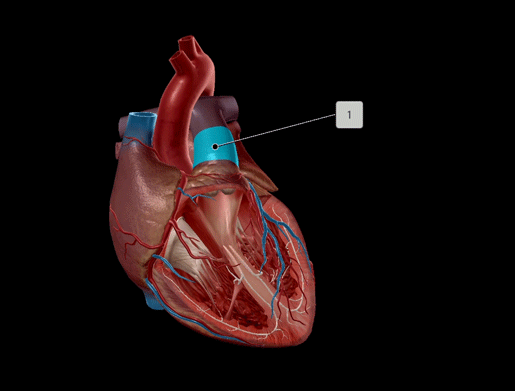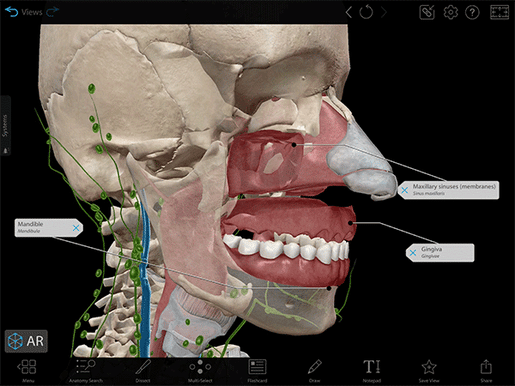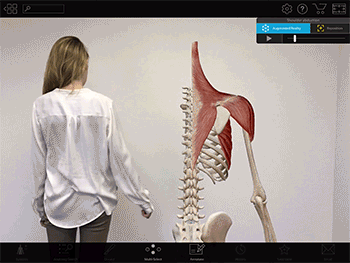3 Reasons College A&P Students Should Use Visible Body
Posted on 10/7/22 by Sarah Boudreau
So you’re a college student with a lot on your plate. You’re trying to reach that school/work/life balance, and you want an anatomy and physiology learning tool that’s worth your while. When it comes to A&P, there’s a lot of information to digest—and to memorize. This is where Visible Body comes in: Visible Body Suite will take your studying to the next level.
When you combine VB Suite’s vast visual library of interactive 3D models, animations, simulations, and 2D histology slides with its quizzes, virtual dissections, and Flashcards, you get a learning experience that will keep you engaged and will reinforce information.
Let’s break down the top three reasons why you can get the most out of your education with VB Suite!
1. You learn better when you use Visible Body
It’s simple: on the whole, students who learn with Visible Body perform better in their A&P classes.
Good grades are nice, but why are they important in the long run? Not only is it necessary to pass your classes to fulfill degree requirements, but learning the material is crucial to passing exams and gaining certifications. Grades matter even after graduation: 73% of employers screen their candidates by GPA. There have been several studies of medical careers that have found that students with better grades tend to become high-performing professionals.

GIF created using VB Suite.
Now that we’ve talked about why it matters, let’s tackle another question: How do we know that Visible Body helps students perform better? To answer that, let’s look at a couple case studies.
Dr. Cindy Harley of Metropolitan State University noticed an improvement in students’ grades when she switched her classes from a textbook to Visible Body.
“I saw a 10% rise in my As, an 8% rise in my Bs, and a 6% decrease in Cs. What this means is those D and F students are moving up to Cs, the Cs are moving up to Bs, and a lot of those Bs are moving into that A range,” Dr. Harley said. Additionally, the number of students who withdrew from the course dropped by 10%.
Not only were students performing better, but they were more likely to stick with the course and receive credits.
This piqued her interest. Had anyone else noticed this big shift? In 2021, she decided to reach out to five other instructors, each at a different institution, about what their classes were like before and after switching from a textbook to Visible Body.
She gathered data for a total of 362 students. 75% of those students were part-time students, aka students with a lot on their plates who had to juggle school with work, childcare, and other responsibilities.
Dr. Harley found that after the five instructors switched to Visible Body, 19% more students received As and grades went up an average of 6.65%—that’s a big improvement.
On an even bigger scale, we can look at LaTrobe University in Victoria, Australia. LaTrobe’s second-year anatomy course enrolls over 4,000 health sciences, exercise physiology, and premed students each year. When the university switched to Visible Body, they saw a significant boost in grades. See for yourself! Check out the graph below that breaks down the grade for an assignment, a final exam, and students’ final grades.
Image from Aaron McDonald and Heath McGowan's webinar on July 13, 2021.
To sum up, students who use Visible Body tend to do better in A&P—and higher scores can correlate to higher performance in your future career.
2. Visible Body is built for learning
3D models are uniquely helpful for learning A&P. Think about it—the body is 3D, so how much can a 2D illustration really teach you?
Studying in 3D requires spatial cognitive processing as you manipulate and navigate the models, and those visuospatial skills are crucial for health sciences professions. Using 3D models means you’re developing your visuospatial skills while you develop your knowledge about the human body. Research even indicates that learning methods that incorporate spatial training result in higher test scores; manipulating 3D models uses sensory memory that can help you retain information for longer.

GIF created using VB Suite.
Bert Oppenheim, Vice President of Creative Services at Visible Body, put it perfectly in this Q&A on 3D learning: “I think of the human body as a gigantic puzzle with thousands of individual pieces that can only fit together one way. [...] When we think of our kidneys, the left kidney sits higher than the right kidney, the reason being that the right kidney has to accommodate the liver which takes up a lot of the space on that right side of the abdomen. If you looked at the position of the kidneys from the front, you wouldn’t imagine they sit so close to your spine unless of course you rotate our 3D anatomical model to the side. The ability to interact with our models provides that understanding and visualization for students learning anatomy.”
Visible Body is built for learning: when we build our apps, we place learning and teaching at the forefront. Unlike other A&P apps that throw a ton of information at you, Visible Body has taken the time to organize content and make the connections between concepts clear, which helps to facilitate high-order thinking. Visible Body products are also built for exploration, allowing you to take your learning into your own hands and go at your own pace.
Speaking of learning at your own pace, you can learn on the go with the VB Suite mobile app. Using your phone’s camera, you can access AR mode to enhance your study experience through AR dissections and more.
3. You can use what the pros use
Visible Body is used in over 1,000 schools, colleges, and universities, but it’s also trusted by healthcare professionals for reference and patient communication.
VB Suite changed the way Dr. Brennen Beatty, an ER physician in Austin, Texas, communicates with patients.
“Previously I found myself constantly using the dry-erase board in the ER to draw crude anatomy. Or if there was a rolling laptop cart in the room, I’d Google an image. If a patient presented with vertigo and dizziness, for example, I’d call up a picture of the inner ear to explain that connection.”
But when he showed patients VB Suite on his phone, they became “wide-eyed with understanding.”
“This technology helps me improve patient experience, compliance with treatment plans, and my overall efficiency,” he said.
This is a perspective shared by Mike Reinold, DPT, ATC, CSCS. In addition to being the co-founder of Champion Physical Therapy and Performance, Mike is the Senior Medical Advisor for the Chicago White Sox and the Director of Baseball Performance at Northeastern University.
“Many people don't click well when it's just a two-dimensional picture from the internet. But being able to see the complete body, different layers of tissue, and how that is impacted from different angles is super helpful. When my patients understand what's going on more, we tend to be more productive in the long run,” he said.

GIF created using VB Suite.
With Visible Body, you can get a head start on using the technology that professionals around the world use to walk patients through their health problems.
Takeaways
Students should use Visible Body products because Visible Body...
- Has a track record of improving grades in A&P
- Is designed for the learning process
- Is used by professionals all around the world
Did you know that your professor doesn’t need to assign Visible Body products in order for you to use them? Individual students looking for a study tool or reference guide can buy a subscription to VB Suite, home to all the visual and interactive content you need to understand the life sciences.
On the data privacy side of things, Visible Body would much rather help you learn than use your data. You can read our privacy notice here, but the big takeaway is this: we don’t sell your information to anyone. After all, we’re in the education business, not the breaking-your-trust business.
Studying for your next big exam? Check out our totally free Learn Site, an introduction to each body system, and browse our premade Flashcards and Tours.
There’s so much information we couldn’t fit into this blog post. If you want to learn more about the benefits of Visible Body, you should check out these posts:
- Can Augmented Reality Improve the Learning Experience of Future Healthcare Professionals? — “AR can reinvigorate the classroom, generating excitement among students and encouraging engagement in course content. More engagement allows students to take a more active role in their learning.”
- Study Smarter with These Three Strategies — “The best way to study isn’t by going over your notes over and over again. Challenge yourself to engage with the material on a deeper level!”
- How Visible Body Supports Executive Function Skills — “Students require more than intelligence and access to research skills to succeed: they need executive function skills. These are the skills that help you reach your goals.”
Be sure to subscribe to the Visible Body Blog for more awesomeness!
Are you an instructor? We have award-winning 3D products and resources for your anatomy and physiology or biology course! Learn more here.



